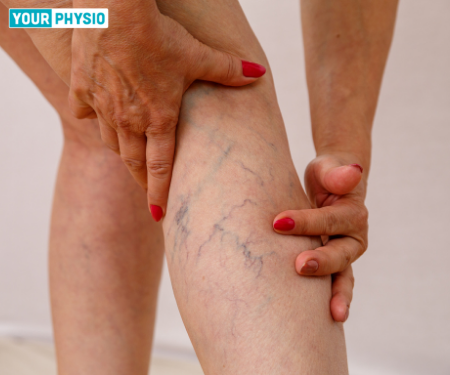Varicose Veins are swollen enlarged veins in legs caused due to impaired venous blood flow. A classic sign of faulty valves in the veins. It is a condition of great socio-economic impact majorly caused due to venous insufficiency and blood pooling in the veins of legs.
Varicose Veins is also known as Chronic Venous Insufficiency. Deep Vein thrombosis being the other kind of Chronic venous insufficiency are both venous diseases due to ineffective pumping of blood back to the heart causing spider veins to appear visibly on the leg.
Many confuse Varicose Veins with Deep Vein Thrombosis and hence, we are here to clear that for you.
Causes of Varicose Veins:
Varicose veins can be caused due to:
Standing for a long time daily (more than 3 hours)
Prolonged usage of heels
Tight clothing leading to pressure on veins in the legs
Increased blood pressure in the veins of legs
Pregnancy
Chronic constipation
Familial or genetic cause
Women are known to get affected more than men
Symptoms of Varicose Veins:
Some common symptoms of varicose veins include:
Constant pain in legs while walking, sleeping and while performing day-to-day activities. The pain is usually relieved by elevating legs above heart level
Swollen legs
Itching sensation in the legs
Increased weight or heaviness in the legs
Increased pain at night, cramp-like pain in the affected leg
Bluish - green colour in legs
Pain while walking at all times of the day, and
Pain in the pelvic region on coughing
How are varicose veins detected?
Varicose Veins are diagnosed using mechanical tests that can be performed on the patient’s leg or by investigations with medical scans.
The two most common tests performed on the patient are Brodie-Trendelenburg Test and Morissey’s cough impulse test.
1. Brodie-trendelenburg test:
The affected leg is elevated for the blood to flow back into the body and a tourniquet or cloth is tied tightly on the distal aspect of the leg. The patient is then asked to stand on his feet quickly and the tourniquet is removed. Rapid filling of the veins with blood indicated venous incompetency or Variccose Veins.
2. Morissey’s cough impulse test:
The affected leg of the patient is elevated and emptied of the blood in it. The leg is then lowered and the patient is asked to cough. Sudden expanding type of pain in the groin or upper leg region indicates varicose veins.
Further diagnosis of varicose veins can be done using Venous Doppler and varicography, in which an instrument with a camera & dye is inserted in the veins to understand the severity of the condition.
Treatment for Varicose Veins
Conservative or natural treatment for varicose veins are remedies you can adopt at home to either stop the disease from worsening and reducing the pain. These conservative methods include:
Elastic crepe bandage application from below upwards or use of pressure stockings to the limb having pressure gradient of 30–40 mmHg.
Elevation of the limb to relieve the swelling pooling of blood . Two times, during day and the entire night, elevation of foot with feet above the level of heart. That is, raising the leg above the body level while sleeping or sitting on a chair.
Unna boots provide non-elastic compression therapy. It comprises gauze compression dressings that contain zinc oxide, calamine, and glycerin that helps to prevent further skin break down.
Pneumatic compression therapy that would provide compression to the leg in intervals throughout the day.
Other forms of treatment for varicose veins can be broadly classified into two categories:
1. Surgical/medical management:
a. Drugs can help with reducing swelling and are mainly used in relieving night cramps but do not improve healing.
b. Surgical management - The affected part of the vein is removed surgically and a vein from another part of your body is grafted in that location.
2. Physiotherapy Management:
a. Educating the patient about the causes, symptoms and home advice for care of varicose veins is crucial. As there would be significant changes in their day-to-day activities due to the pain. Weight control, care of limbs and optimum exercises for the affected leg is necessary for faster recovery. Treatment includes:
b. Compression stocking (CS): It is based on the use of compression therapy, which is a “gold standard,” means of minimising the symptoms of varicose veins. It can be applied using elastic stockings, bandages and pneumatic compression devices. Most patients experience relief from the pain and other symptoms by long-term usage of compression stockings. Stockings when worn daily are the ideal treatment for patients who do not want surgery.
c. Exercise- Regular exercise helps in the pumping action of blood back into the heart, as part of the normal blood circulation of the body. Immobility or sedentary lifestyle prevent the calf muscle contracting adequately resulting in impaired venous blood return to the heart. This can further worsen varicose veins progression in the patient’s body causing pooling of blood in the limbs. Exercising twice a week by simply walking, light jogging and stair climbing can relieve the person of pain and even prevent the further progression of the condition.
Kinesio Taping- Kinesio Taping involves taping the skin which aids in the circulation of blood along the tapes ridges and grooves if done well. Kinesio Tape (frequently used in edema, hematoma and wound healing) has been used as an alternative to compression therapy in patients with venous diseases in recent years.
Important Note- Varicose vein treatment in India focuses mainly on the conservative remedies and physiotherapy. LASER and sclerotherapy surgery have also proven to reduce the recurrence of Varicose veins in India.

Illustrations designed by freepik